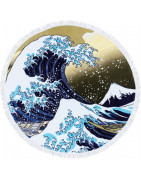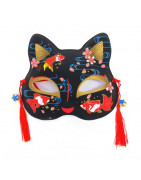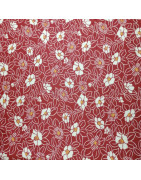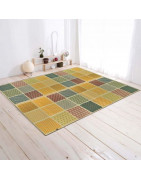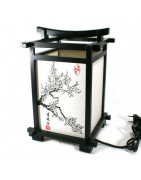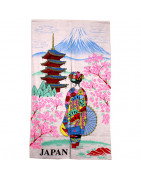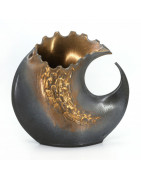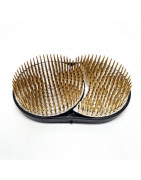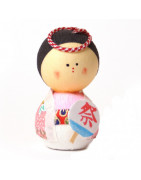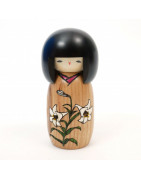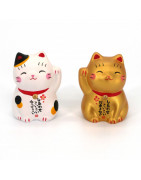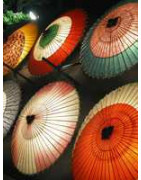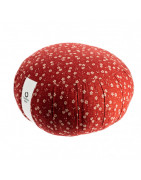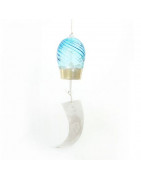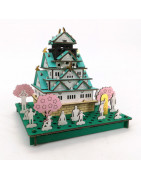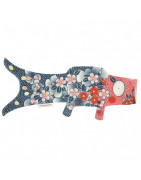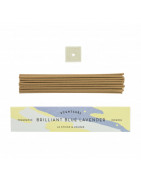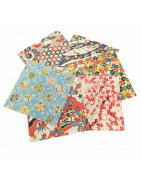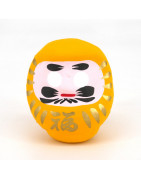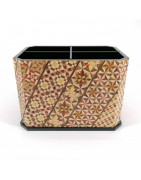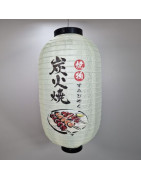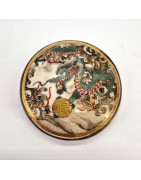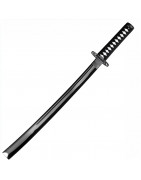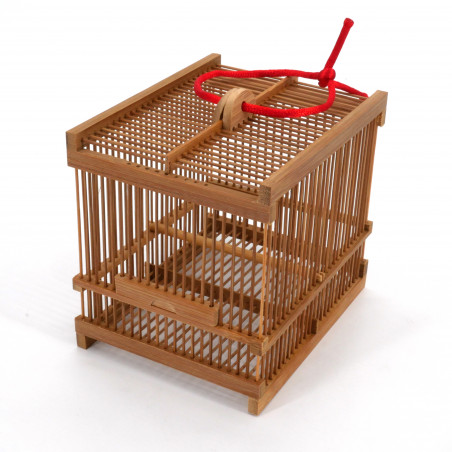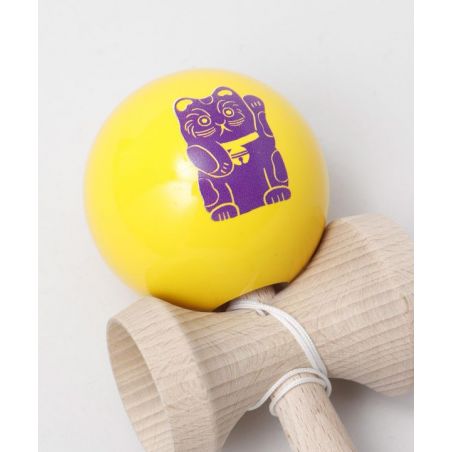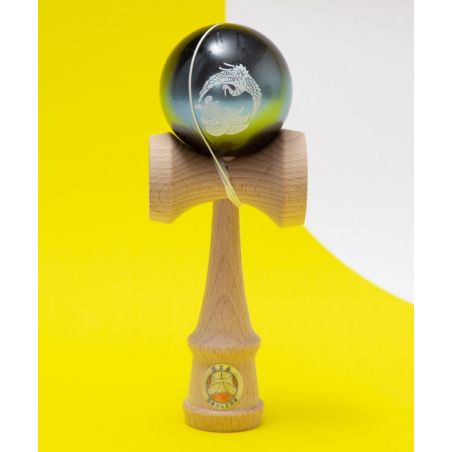Japanese interior and decoration items - Unique pieces for your home
Japanese interiors and decoration are characterised by simplicity, minimalism and respect for nature. Traditional Japanese houses are often built of wood and have thatched roofs, paper walls and wooden floors. Rooms are often separated by sliding walls called shoji, which can be opened to create an open space or closed to create private rooms.
The colours used in Japanese interiors are often neutral, with shades of beige, brown and grey. Natural materials such as wood, stone and bamboo are often used for furniture and accessories.
Japanese decoration is also influenced by the seasons and natural elements. Flowers and leaves are often used for decoration, with plants such as bamboo, pine and cherry blossom being particularly popular. Crafts such as pottery, lanterns and straw mats are also used to add texture and warmth to the space.
Furniture arrangement is also important in Japanese decoration, with furniture often arranged to create an empty space around it, giving a sense of calm and relaxation.
Finally, the Japanese interior is often characterised by a number of rooms dedicated to specific activities such as meditation, tea ceremony, martial practice or study.
If you can't go to Japan, Japan will come to you! Give your home a Japanese touch with our range of objects.
Subcategories
-
Japanese Linen -...
There are several types of linen in Japan, each with unique characteristics and uses. The most common types of linen in Japan include:
Furoshiki: These are square pieces of cloth that are used to wrap items such as gifts or food baskets. Furoshiki are often made from traditional Japanese fabrics such as cotton or linen, and may be decorated with traditional Japanese designs.
Tenugui: These are rectangular pieces of fabric that are used as towels or headbands. Tenugui are often made from cotton and can be decorated with traditional Japanese patterns.
There are of course other items of linen that are used in Japan, it depends on the region and the tradition of each. -
japanese figurines
Decorate your home with our selection of Japanese statuettes
-
Japanese Masks -...
Japanese masks are traditional Japanese masks that are used in the performing arts, such as Noh and Kabuki theatre, as well as in religious ceremonies and festivals. Japanese masks can take the form of any character or animal, and are usually made from wood or papier-mâché, and painted by hand. Japanese masks are often decorated with delicate details and bright colours to make them more expressive.
Japanese masks have a long history in Japan, dating back to the Edo period (1603-1868) when they were used in Noh plays to depict mythical or historical figures. Japanese masks are also used in Shinto religious ceremonies and festivals to represent deities or spirits.
Japanese masks are considered symbols of tradition and art, and are often used to create an atmosphere -
Japanese Patterned...
Japanese patterned fabrics are traditional Japanese fabrics that are made from natural materials such as cotton, linen or silk, and are decorated with traditional Japanese motifs such as cherry blossoms, bamboo leaves, birds and fish. Japanese fabric designs are often inspired by nature and are often associated with seasons or important events.
There are a variety of types of Japanese fabrics, each with its own characteristics and uses. The best known Japanese fabrics include kimono, which is a traditional Japanese garment, furoshiki, which is a fabric used to wrap objects, and tenugui, which is a fabric used as a towel or headband.
Japanese patterned fabrics are often used for clothing, curtains, bedspreads, towels, bags, pareos, tablecloths and home decor. Traditional Japanese patterns add a touch of culture and sophistication to any sewing or interior design project. Japanese patterned fabrics are considered symbols of tradition, culture and beauty, and can be used to create unique and interesting items for your home. -
Japanese rugs and...
Japanese mats and tatami are traditional Japanese floor coverings made from rice straw, reeds or rushes. Tatami mats are usually made from pressed rice straw covered with a woven reed or rush cover. They are used to cover the floors of traditional Japanese houses, bedrooms and meditation rooms. Japanese rugs are usually made from natural fibres such as cotton, linen, wool or silk and are often decorated with traditional Japanese motifs such as cherry blossoms, bamboo leaves, birds and fish.
Tatami mats are considered an important part of traditional Japanese architecture, as they help to insulate rooms from cold and wet floors. They are also used for meditation and yoga practices as they are considered comfortable and hygienic to lie or sit on. Japanese rugs are used to add a touch of culture and tradition to a room, they can be used to decorate a living room, bedroom, bathroom, etc. Japanese rugs and tatami mats are considered symbols of tradition, culture and comfort, and they can be used to create a warm and comfortable atmosphere in a room. -
Japanese Lamps: The...
Japanese lamps are important elements of traditional Japanese interior architecture, which have been used to light homes and temples for centuries. There are many types of Japanese lamps, each with its own characteristics and uses.
Oil lamps (chōchin) are one of the most common types of Japanese lamps. They are made from rice paper and usually have a cylindrical shape with a bamboo handle. Chōchin are often used to light Buddhist temples and private homes, and are often hung from ceilings or hung from support poles.
Stone lanterns (ishidōrō) are also a popular type of Japanese lamp. They are made from stone and usually have carved or engraved designs on them. Ishidōrō are often used to light gardens and stone walkways, and are often used to illuminate Shinto temples and shrines.
Table lamps (andon) are another type of Japanese lamp that is often used to light living rooms. They are made from wood and usually have a rice paper shade. Andons are often used to light living rooms, bedrooms and bathrooms. -
Japanese Noren:...
Noren are fabric curtains traditionally used in Japan to separate spaces or to mark the entrance to a shop or home. They are usually made of cotton or linen, and can be decorated with patterns or inscriptions that have special meaning.
Noren are often used to separate interior spaces, such as bathrooms or bedrooms, or to mark the entrance to a shop or home. They can also be used to protect the occupants of the house from direct sunlight or to protect furniture from scratches.
There are many types of noren, each with unique patterns and meanings. Some noren have plant or animal motifs that represent prosperity or longevity, while others have kanji inscriptions that represent proverbs or good luck wishes. Noren can also be personalised with images or inscriptions to mark the entrance to a shop or house.
In summary, noren are fabric curtains traditionally used in Japan to separate spaces or to mark the entrance to a shop or home. They are usually made of cotton or linen and can be decorated with patterns or inscriptions that have a special meaning. There are many types of noren, each with unique designs and meanings, and they can also be personalised. -
Japanese vases for...
Ikebana is a traditional Japanese floral art form that involves creating floral arrangements in special vases called "kadō-bon" or "ikebana vases". These vases are often made of ceramic or wood and have unique shapes that are designed to showcase the flowers and foliage used in the arrangements.
Ikebana vases are usually slender and narrow, allowing the stems and foliage to rise vertically. They can have simple or more complex shapes, such as three-branched vases or multi-compartment vases. Ikebana vases are often used for formal flower arrangements, such as those used for ceremonies or exhibitions.
Ikebana vases also have symbolic meanings related to the different types of flowers and symbols used in the arrangements. The colours, shape and materials used in Ikebana vases are chosen to reinforce the meaning of the flower arrangement. -
Japanese Kenzan -...
Kenzan are tools used in Japanese flower arranging to hold flowers and branches in place in a vase or flower arrangement. They are usually made of metal and have spikes that can be driven into the flower stems to hold them in place. Kenzan can be used to create traditional flower arrangements such as Ikebana.
Kenzan are also known as "stem clamps" or "stem stakes", and are used to hold flowers and branches in place in a vase or floral arrangement. There are many sizes and shapes of kenzan available to suit different types of floral arrangements. Kenzan can be used for cut flowers or bonsai branches. Some kenzan are equipped with rubber or cork washers to protect the flower stems from damage. Kenzan are often used in combination with wire or ribbons to hold flowers and branches in place more precisely.
It is important to note that the use of kenzan requires some practice and dexterity to achieve aesthetic results. Ikebana, the Japanese floral art, is a good example of the use of kenzan, it is based on principles of composition and symbolism to create elegant and balanced floral arrangements. -
Japanese...
Okiagari-koboshi, also known as 'rising dolls', are traditional Japanese dolls that have the ability to stand up after being pushed. They are made from paper mache or glutinous rice and are usually painted with bright colours and traditional designs.
Okiagari-koboshi are used in Japanese tradition to teach children the importance of standing up after being hit by life's difficulties. Adults also use them as symbols of perseverance and determination.
They are often used in folk culture ceremonies, such as spring festivals or year-end ceremonies. Okiagari-koboshi are often seen as symbols of good luck and good fortune, and it is said that having an okiagari-koboshi in one's home can bring luck and perseverance. -
Japanese Kokeshi: The...
Kokeshi are traditional Japanese dolls that were created in the mountainous regions of northern Japan centuries ago. They are made from cedar or cherry wood, and usually have a round head and cylindrical body. Kokeshi are often painted with colourful patterns and decorated with traditional Japanese clothing.
Kokeshi were originally created as toys for children, but have become popular as collectibles and decorative items. There are several different styles of kokeshi depending on the region where they were made, each with distinct characteristics such as head shapes, paint patterns and clothing styles.
There are also modern kokeshi, created for collectors and tourists, which can be made from materials such as resin or plastic. Modern kokeshi are often more colourful and detailed than traditional kokeshi and can be used as decorative objects. -
Discover the...
The manekineko is a Japanese symbol of luck and prosperity. It is represented by a cat (or sometimes a kitten) holding a raised paw, often holding a coin or a hairball. It is often used as a decorative object, especially in shops and restaurants.
The history of the manekineko dates back to the Edo period (1603-1868) in Japan. There was a popular belief that cats had the ability to ward off evil spirits and bring good luck to people. Shopkeepers began placing ceramic cat statues at the entrance to their shops to attract customers and prosperity.
Over the years, manekineko ceramics became more popular and became a common cultural symbol in Japan. It is now used as a good luck charm for business and personal life, and is often given as a gift to family and friends. It has also become popular in other parts of the world, including Asia and North America, as a symbol of good luck and good fortune.
There are several variations of the manekineko, each with a different meaning. For example:
the manekineko holding a coin is believed to attract wealth and financial prosperity.
the manekineko holding a raised paw is supposed to attract customers for business.
the manekineko holding a sake stick is supposed to attract good fortune and prosperity in social life and relationships.
There are also differences in the colour and position of the cats, such as the white maneki-neko which is supposed to attract peace and serenity, or the black maneki-neko which is supposed to attract protection from evil spirits.
It is also interesting to note that legend has it that the first manekineko was created for a Shinto temple in the Wakayama region of Japan, where a priest noticed a cat inviting travellers into the temple by raising its paw. So he created a cat statue to attract people into the temple.
In conclusion, the manekineko has become a popular cultural symbol in Japan and around the world, used to attract luck, prosperity and good fortune in business, personal life and relationships. -
Japanese parasols -...
Japanese umbrellas, also known as "wagasa", are traditional Japanese parasols made from bamboo and washi paper (traditional Japanese paper). They are used both as fashion accessories and as protection against rain and sun. Japanese umbrellas are usually handmade by experienced craftsmen, and can be found in a variety of sizes, shapes and patterns.
Japanese parasols have a long history in Japan, dating back to the Edo period (1603-1868). They were often used by court ladies and geishas to protect themselves from the sun during ceremonies and outings. Japanese parasols are also used for fashion shows, weddings and religious ceremonies.
Traditional Japanese designs such as cherry blossoms, bamboo leaves, birds and fish are often used to decorate Japanese parasols. Japanese umbrellas can be found in a variety of colours, ranging from bright and bold to more subdued and subtle.
Japanese parasols are considered symbols of beauty, refinement and protection. They can be used to add a touch of elegance to a look, or to protect from rain and sun. -
Japanese Cushions and...
Japanese makura (or pillows) and cushions are important elements of Japanese culture that have both practical and aesthetic roles. Makura are traditional pillows used to support the head when meditating or reading, while cushions are used to support the back and legs when sitting cross-legged or crouching. Makura and Japanese cushions are usually made from natural materials such as cotton, linen or silk, and may be filled with duck down, kapok or buckwheat hulls.
Makura and Japanese cushions can also be used as decorative elements in the home, particularly in bedrooms and living rooms. They are often used to create a Zen or traditional setting, and can be found in a variety of sizes, shapes and patterns. Traditional Japanese designs such as cherry blossoms, bamboo leaves, birds and fish are popular.
In general, makura and Japanese cushions are considered symbols of comfort and luxury, and they can be used to create a relaxing and restful atmosphere in a room. -
Japanese Glass Furin -...
Furin are traditional Japanese glass wind chimes. They are usually made from mouth-blown glass and can be of various sizes and shapes. Furin are hung outside houses or buildings, usually in gardens or courtyards, and are designed to tinkle when the wind blows through them.
Furin have a long history in Japan, dating back to the Edo period (1603-1868) when they were made from bronze or copper. Glass furin were introduced later, during the Meiji period (1868-1912), and became very popular because of their unique crystal sound and elegant appearance.
Furin are often made with traditional Japanese motifs such as cherry blossoms, bamboo leaves, birds and fish. Some furin are even engraved with poems or proverbs to add an extra dimension of cultural significance.
Furin are considered symbols of good luck and prosperity, and can be used to create a peaceful and refreshing atmosphere in a garden or yard. -
Japanese Paper Models...
Japanese paper models, also known as "kirigami" or "origami", are paper models created using traditional Japanese paper folding techniques. Japanese paper models can take the form of all sorts of things, from animals and characters to buildings and vehicles. They are usually made from rice paper or washi paper (traditional Japanese paper), and can be coloured or decorated with traditional Japanese motifs such as cherry blossoms, bamboo leaves and birds.
Japanese paper models are often used as decorative objects, but they can also be used for educational purposes or as a creative hobby. Japanese paper folding techniques are considered an art, and there are competitions and exhibitions dedicated to Japanese paper models.
Japanese paper models are considered symbols of patience, precision and creativity, and can be used to create unique and interesting decorative objects. -
Japanese Koinobori:...
Koinobori are fish-shaped flags that are traditionally used in Japan to celebrate Tango no sekku, which is also known as 'Boys' Day'. This festival is celebrated every year on 5 May and is intended to wish the boys in the family good health and development.
Koinobori are usually made of cloth and painted in bright colours, often red, blue and white. The largest of the flags is traditionally the one representing the father of the family, followed by smaller flags for the sons. It is common to see koinobori flying in the wind on poles next to houses or buildings during this period.
It is said that the origin of koinobori dates back to the Edo period (1603-1868) and that the flags were introduced to celebrate boys and wish them good health and success. Today, these flags are still used for the same reason and have become a strong symbol of Japanese popular culture.
In short, koinobori are fish-shaped flags traditionally used in Japan to celebrate Boys' Day, which takes place every year on 5 May. They are usually made of cloth and painted in bright colours, and are often seen flying in the wind on poles next to houses during this time. Koinobori have become a strong cultural symbol in Japanese popular culture. -
The different types of...
There are several types of Japanese wall decorations that can be used to add beauty and authenticity to a space. Here are some examples:
"Kakemono" are scrolls of traditional painting or calligraphy that can be hung on the wall. They can depict natural scenes, cultural symbols or proverbs.
Byōbu" are paper or fabric screen panels that can be used to separate spaces or to add wall decoration. They may depict nature scenes, historical figures or cultural symbols.
Kakejiku" are posters or scrolls made of silk or paper that can be hung on the wall. They may depict nature scenes, historical figures or cultural symbols.
Tatami-omote" are floor coverings made of rice straw that can be used to cover walls or ceilings. They can add texture and authenticity to a space.
Shikishi' are paper or silk plates with painted or calligraphed phrases or poems.
There are many other types of Japanese wall decorations, but this gives a general idea of what is available. These decorations can add beauty, authenticity and culture to a space, while reinforcing the desired Zen and traditional atmosphere. -
Japanese incense:...
Japanese incense, or "kōdō" in Japanese, is a traditional practice of burning incense to scent the air and create an atmosphere for meditation or relaxation. The practice dates back many centuries, and Japanese incense is made from natural raw materials such as woods, herbs and resins.
There are many types of Japanese incense, each with unique scents and meanings. Some incenses are used to purify the air and ward off bad energy, while others are used to promote meditation or to create an atmosphere conducive to relaxation. Japanese incense can also be used to celebrate important events or to mark special occasions.
The practice of burning Japanese incense is often associated with Zen culture and is considered an art form. There are special incense burning ceremonies, called "kōdō-kai" which are held to honour incense masters and to display rare and precious incense. -
Incense holders -...
Incense holders are objects used to hold and burn incense. They are often used in religious or spiritual practices, as well as in Japanese culture to scent the air and create a pleasant atmosphere. Incense holders can be made from a variety of materials such as wood, stone, metal or ceramic, and they can take different forms such as vases, boxes or trays.
Japanese incense holders are often made from cedar wood and bamboo, and are often decorated with traditional Japanese motifs such as cherry blossoms, bamboo leaves, birds and fish. There are also Japanese ceramic and metal incense holders. Ceramic incense holders are often decorated with motifs inspired by nature, while metal incense holders are often decorated with delicate engravings.
Japanese incense holders are used to scent the air and create a pleasant atmosphere during religious ceremonies, tea ceremonies, wedding ceremonies, etc. They are also used for meditation and to create a sense of well-being. They are also used for meditation and relaxation. Japanese incense holders are considered symbols of purification and spirituality, and they can be used to create a peaceful and refreshing atmosphere in a room. -
Japanese Papers: The...
Washi paper is a type of traditional Japanese paper made from mulberry (kozo), gampi and mitsumata fibers. It is known for its soft texture, transparency and water resistance. Washi is used for a wide variety of applications, ranging from artistic applications, such as calligraphy and printmaking, to practical applications, such as packaging and stationery.
Washi paper is handcrafted using traditional techniques that date back centuries. The fibers are sieved, mixed with water and pressed to remove excess water. The paper is then spread out on wooden boards to dry, then cut into sheets.
Washi is also known for its aesthetics, due to its natural texture, transparency and water resistance,
-
Daruma dolls: symbols...
Daruma are traditional Japanese dolls that represent Bodhidharma, the founder of Zen Buddhism. The doll's eyes are usually painted white, and one of them is blackened when a goal or intention is set. When the goal is achieved, the other eye is blackened as well. Daruma are often used as good luck charms and to remind an individual to persevere in their efforts to achieve their goals.
Daruma are often made of papier-mâché or wood, and are round in shape to symbolise balance and stability. They are also often painted red, as it is considered a lucky colour in Japan. Daruma are often given as gifts when a person starts a new project or business, or to celebrate an important event. They can also be used to help overcome obstacles and challenges. Daruma are a popular symbol in Japanese culture to remind a person to never give up and to pursue their dreams. -
Hakone Marquetry:...
Hakone Marquetry is a traditional Japanese marquetry style that originated in the city of Hakone, Kanagawa Prefecture, Japan. It is known for its intricate and detailed designs, often inspired by nature, such as flowers, butterflies and birds. It is usually made from precious woods such as rosewood, cherry wood and sandalwood, and uses careful cutting and gluing techniques to create highly detailed designs.
Hakone marquetry is often used to make boxes, trays, furniture and other decorative items. It is also often used to decorate stationery items such as diaries and notebooks.
Hakone marquetry is considered one of the most elaborate forms of Japanese marquetry, with years of learning and practice required to master the techniques. It is considered a traditional Japanese art form and is protected by the Japanese government as such. -
Japanese Lanterns:...
Discover the ancient art of Japanese Chōchin lanterns, exquisite craftsmanship that combines beauty and tradition. These paper and bamboo lanterns provide soft and soothing light, creating a warm ambiance in your space. Used for centuries in Japan, they are more than just illumination; they represent Japanese culture and elegance. Explore our diverse collection of Chōchin to add an authentic touch to your decor and immerse yourself in the serenity of Japanese culture.
-
The Universe of...
Explore our exceptional collection of figures inspired by the worlds of Manga, Anime, and Tokusatsu. Each piece is meticulously crafted to capture the essence of your favorite characters. Whether you're a fan of iconic series or new hits, our figures are perfect for enhancing your collection or decorating your space with unique and authentic pieces.
-
Japanese Antiques –...
Our collection of Japanese antiques offers a fascinating glimpse into the history and culture of Japan. Each piece, ranging from traditional ceramics to period furniture, is a testament to the past and reflects the craftsmanship of Japanese artisans. Whether you are an experienced collector or a history enthusiast, you will find unique works that will enrich your space and bring a touch of Japanese tradition to your home.
-
Decorative Japanese...
Add a touch of Japanese culture to your decor with our decorative Japanese katanas. These authentic pieces capture the spirit of the samurai and bring unique elegance to your home.

.jpg)

















































































